By Tony Wright
Paddy Garrity was manning his celebrated bar at the Victorian Trades Hall in Carlton on a soft September evening in 2000 when protesters began limping in.
They were the walking wounded from a police baton charge outside the Crown Casino during an anti-globalisation demonstration at the World Economic Forum.
The comedian Rod Quantock, battered himself though a mere observer, remembers Garrity’s dismayed expression as young women arrived, blood streaming from their faces.
“There he was, the bar open, free drinks for everyone, and suddenly Paddy burst into tears,” Quantock says.
Garrity was a man of great passion, though he is better remembered for the knowing mischief in his eyes than for tears.
The Melbourne-based actor and writer Mary Kenneally, partner of Quantock, remembers Garrity as “a glory of a person - just happiness on legs”.
Garrity combined an abiding love of the arts with a lifetime commitment to working people and the oppressed, eventually knitting his passions together in the bar - Paddy’s Bar, inevitably - and the series of performance spaces he established within Trades Hall, Melbourne’s historic home of unions.
Born in north-east England in 1937, he migrated aged 14 with his family to Australia in 1951.
Early in his life he became a merchant seaman on ships plying the Australian coast, where his lifelong attachment to the union movement was formed. He was a member of the now deregistered Painters and Dockers, but his membership of the Seamen’s Union stayed with him to the end.
Committed to numerous causes from the East Timorese to supporting striking dock workers during the 1998 waterfront dispute, he believed in lifting the horizons of working people by exposing them to the arts.
Quantock became a friend in 1976 when Garrity invited him to perform at lunchtime for workers at the Kraft factory in Port Melbourne. Over the next three decades, there was barely a performing artist in Melbourne and beyond who did not form a friendship with the impish Garrity.
When it was learned Paddy Garrity had died of COVID-19 on Sunday morning, August 16, the flag that flies above Trades Hall was lowered to half mast and stayed there for two days.

Paddy Garrity in the ballroom of his beloved Melbourne Trades Hall in 2002. Also pictured: Jim Rimmer.CREDIT:PAUL HARRIS
The secretary of Trades Hall, Luke Hilakari, said it was difficult to sum up such a rich and varied life.
“Paddy Garritty was a seaman, a painter and docker, the Secretary of the Unemployed Workers Union, a publican, a shopkeeper, a community activist, a circus rigger, a champion of the oppressed, a trade union activist, promoter of the arts and a comrade to many,” he said.
Garrity himself, boasted of just one great achievement. He was famed for telling everyone he met that he was the world’s luckiest man because he had a beautiful partner named Mary.
He and Mary Price, then a nurse at the Royal Melbourne Hospital, met 35 years ago at a party in Fitzroy after a Palm Sunday peace rally.
“I thought he was a bit cheeky, a bit of a character,” says Mary. “He opened my eyes to so many things. We had a wonderful life together.”
Garrity was at the time the arts officer at the Williamstown Naval Dockyards.
He had already established in Tasmania the Unemployed Workers Union, creating work for the jobless by establishing a thriving health food business. Somewhere in there, this man of parts served as rigger for the famed performing group, Circus Oz.
In 1996, the then secretary of Trades Hall, Leigh Hubbard, was taken by Garrity’s infectious vision of returning the old building to its roots as a home of the arts.
“Paddy was a man of great stories and infectious humour, but it was the eyes that got you - you fell into them, as if you could see into his good soul,” Hubbard said.
The union movement had gone through a series of amalgamations, and many of the big new unions had moved out of the Hall.
Garrity saw an opportunity. He knew of the building’s history from the 1860s when there had been an art school on site that taught some of Australia’s great artists, including Frederick McCubbin and Tom Roberts.
With Hubbard’s encouragement, Garrity got a bar running. Soon he engaged with the Melbourne Comedy Festival and the Fringe Festival, making Trades Hall one of Melbourne’s most beloved venues. What had been called the people’s palace once again opened up to Melbourne’s workers and creatives.
Early this year, Hilakari took Garrity - whose health had become frail for some years - on a tour of the much restored Trades Hall.
“He was so pleased to see the grand old rooms, like Solidarity Hall, The Ballroom, the Old Council Chambers and a workers museum being again a first-class space for the working class. He had tears in his eyes: the building meant that much to him,” Hilakari said.
Hubbard said Melbourne and the trade union movement had been fortunate to have Paddy Garrity in its orbit.
“We won’t see many like him ever again,” he said.
Patrick Garrity, 83, died in a Melbourne nursing home where he had been resident for three years.









